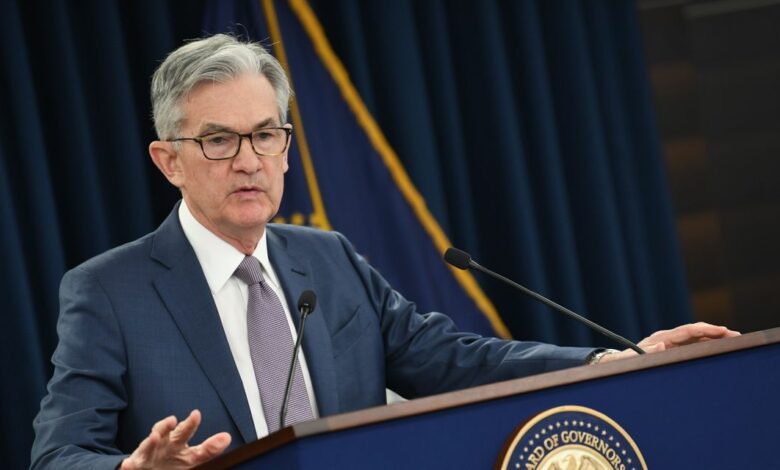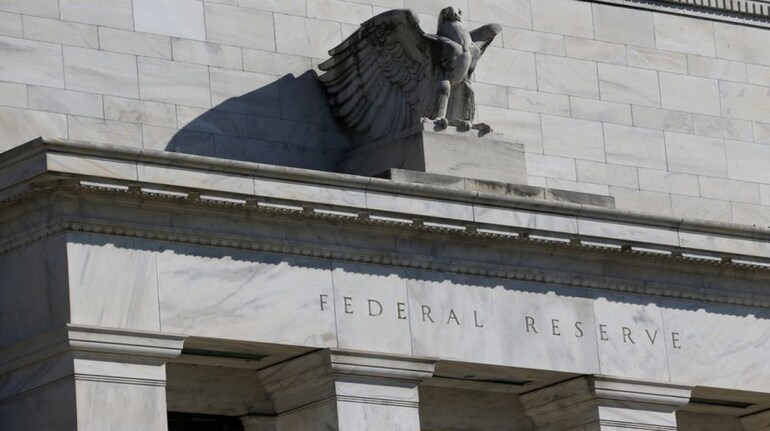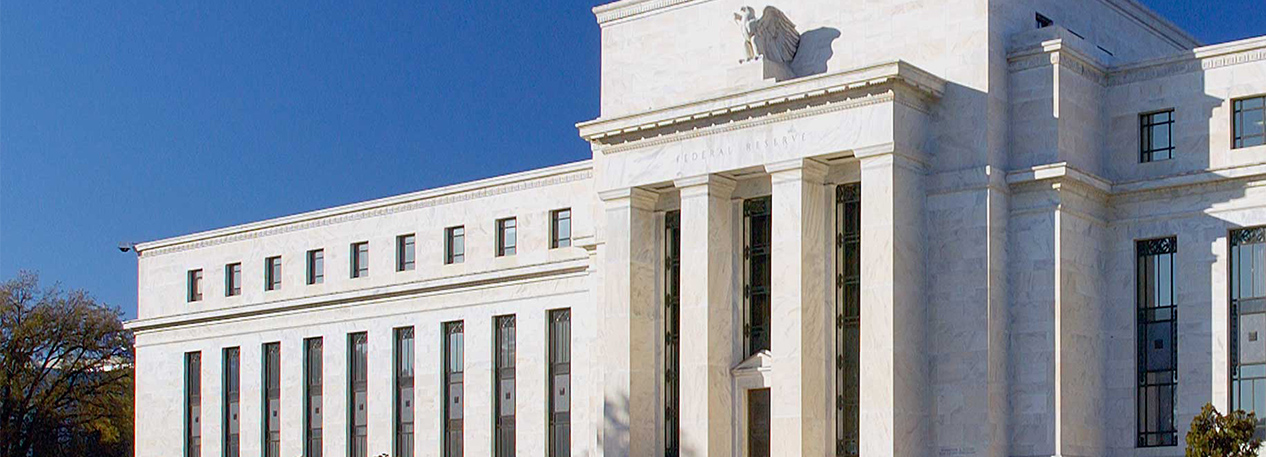The Fed hikes the interest rate by 0.75%

The Fed announced the most aggressive interest rate in nearly thirty years.
Federal Reserve raised the benchmark borrowing rate by three-quarters of a percentage point on Wednesday as it battles against surging inflation.
The world’s biggest Economy is fighting four-decade high inflation. In an aggressive drive to tame the surge, the U.S. federal reserve had raised its key interest rates by 75 basis points. It is the most significant hike in nearly three decades, with a 0.75 per cent hike. The short-term benchmark rate is now in a range of 1.5 to 1.75 per cent.
The super-size move was the first 75 basis point increase since November 1994. Taking aggressive action to help take bold action to help tame historical inflation. Since 1994, the federal reserve raised interest rates by remarkable three-quarters of a percentage point for the first time.
Chairman Jerome Powell announced the fed policy meeting on Wednesday ” This continues our approach of expeditiously moving our policy rate up to more normal levels, and it will help ensure that longer-term inflation expectation remains well anchored at 2 percent.”
The move comes after May’s hotter expected inflation report and Wall Street’s growing call for stricter action from the Fed to keep prices under control.
” We know that high inflation imposes significant hardship, especially on those least able to meet the higher costs of essentials like food, housing, and transportation. ” _ Chairman Jerome Powell.
The hike affects many consumers and business loans. Inflation has reached a four-decade high of 8.6 Percent. The centre is ramping up its drive to slow growth. Us growth inflation has been worsened by Russia’s war against Ukraine and its effect on energy prices. Shortages of oil, gasoline and food are also propelling the inflation in the country.
The U.S. central bank is under intense pressure to curb soaring gas and food prices. The decision to impose a rate hike as significant as this is an acknowledgement that the Fed is struggling to curb the pace and persistence of inflation.
Federal Reserve Chairman Jerome says, “Clearly, today’s 75 basis point increase is a huge one, and I do not expect moves of this size to be common. In today’s perspective, either a 50 basis point or 75 basis point seems most likely in our next meeting. We will, however, make our decisions meeting by meeting and will continue to communicate our thinking as clearly as we can. Our overarching focus is using our tools to bring inflation back down to our Percent goal and to keep longer inflation expectation well anchored.”
U.S. central bank has flagged higher rates. The benchmark interest rate could see another 0.75 percentage point hike in July. The officials projected the world rate to increase to 3.4 per cent by the end of this year itself and to 3.8 per cent in the year 2023. The U.S. central bank stressed that they are determined to slow inflation but not by derailing the American Economy.
“We have both tools and the resolve it will take to restore price stability on behalf of American families and businesses. Not trying to induce a recession so let’s be clear about that. We’re trying to achieve two percent inflation consistent with a strong labor market. That’s what we are trying to do.” _ Chairman of Federal Reserve
Meanwhile, a downgrade to the Fed’s economic outlook accompanies the tightening of monetary policy. The U.S. central bank projected a slowing economy and rising unemployment in the months to come. The U.S. economy is seen slowing to a 1.7 per cent growth this year. The forecast was at 2.8 per cent earlier. Unemployment is projected to rise to 3.7 per cent by the end of this year itself and continue to rise to 4.1 through 2024.
Following the release of the statement and economic projections, investors cheered the federal reserve’s decisions. Wall Street Closed sharply. Higher government-born yells and the dollar retreated from multi-year highs.
But that solid response to help the Economy has some economists worried about former Fed chairman Ben Bernanke. Cautioning future financial conditions is hard to forecast. Financial Experts say higher interest rates could be felt widely regarding consumer borrowing, from credit cards and mortgages to car loans. In the United States, anyone with a home mortgage, a car payment, or even a credit card will be affected by this news.
The Fed wants to cool off the labour market without increasing unemployment, something economists say is easier said than done; however, Fed Chairman Jerome Powell is optimistic, saying it is possible in a post-pandemic economy.
What is the Federal Reserve?
You may have heard of the Federal Reserve or the Fed. But What is that? And how does it affect?
The Federal Reserve is the Central Bank of the United States, even though it acts as an independent agency. It is still a part of the federal government. Some people call it the banks of banks.
Their goal is to encourage high Employment and economic growth while keeping inflation under control. To Accomplish this Outcome, The federal reserve has several tools it can use, but one essential tool is controlling interest rates, which is the cost of borrowing money.
In the same way, people borrow money from banks, and banks need to borrow money from somewhere. That’s where Fed comes in, and when the banks borrow money from Fed, the fed gets to decide what the interest rate banks will pay on their loans.
When the Fed raises or lowers interest rates from banks, the rate that bank charges consumers for everything, including credit cards, auto loans, and home, but how does this impact the Economy if the Economy is not doing well?
The Fed will likely lower interest rates to encourage business expansion and increase consumer spending, which can help kick-start a sluggish economy.
If the economy is growing too fast and inflation increases, the federal reserve can increase rates so growth can be slowed and stabilized.
These decisions, along with other policy choices, are made by 12 leaders within the federal reserve called the Federal Open Market Committee. The Federal Open Market Committee is made by the Fed chairman, appointed by the President. The Fed board of governors and a rotated regional Federal Reserve Bank Presentations group.
The decisions made by the Fed are primarily isolated from Political Pressure because one member of the Board Of Government is fixed. The Fed is not held hostage by congressional funding. The President of the U.S. to remove a member from office for just cause has rarely been used.
The Federal Reserve plays a significant role in the U.S., and understanding how it can be beneficial when trying to understand the broader economic policy.
What do Rising Interest Rates Mean?
Central Banks such as the Federal Reserve in the U.S. and the Bank of Canada in Canada, are entities with the mandate of stabilizing economic activity and promoting Prosperity. One of the ways they do this is by controlling the rates at which banks can borrow money from other large banks in the overnight market.
These Interest Rates have far-reaching impacts on business activity because they underline all their loans in the country. As they go up, so do interest rates for mortgages, lines of credit, and even company bonds. So they are important metrics to watch when engaging our Economy

After the 2008 financial Crisis, for Eg: the Central banks lowered their policy rates to the Economy through turbulence and have had low rates since then. This means that since 2008 banks have been paying low rates on their loans which allowed them to also loan out money at cheaper rates to businesses and consumers.
This means that companies have had lower costs for some time, allowing them to hire more people. This higher Employment implies that consumers have had more money which has translated into higher spending over the last decade.
But As we mentioned, Central banks started to increase their cost of loans, meaning that companies and consumers will soon need to pay more for their debt. This will make it more difficult for firms to pursue ventures and hire more people, who could hit Employment and consumer wealth as companies cut back on spending.
It seems like a wrong move, so why would central banks do this when things are looking up well? Unfortunately, in economics, things being too good can be a problem. One way to think about it is to imagine a car engine built to run at a maximum of a hundred miles per hour. It is possible to put the Engine further, but doing so would cause the unit to overheat, leading to some damage. If the Engine doesn’t cool down and reduce its speed, the Economy works.
Similarly, the country can operate at a sustainable level of activity. When things move faster than expected, the system overheats and causes some issues, so the central bank looks to slow down activity when it’s growing too rapidly.
Here’s a more detailed breakdown; when economic activity is high, we often see an increase in consumer demand for goods and services since more people are employed and have more money to spend. If this demand grows too quickly, the goods will increase their prices, leading to INFLATION.
/GettyImages-471002109-bae5d7aa291c4fd9809c0ac6f57d3cc9.jpg)
Inflation is when the value of cash falls because prices are increasing, and your money loses its ability to buy as many goods and services, which means your wealth diminishes.
Over time, we have experienced low levels of inflation every year—the central bank’s target of rapid around two per cent every year to avoid a shrinking economy. But in the future, this inflation rises when more consumers’ wealth diminishes, which causes a crisis if left unchecked, so when things start to overheat, central banks will increase the policy rates and make it more expensive to borrow money which will decrease the demand and keep inflation at bay.
While indeed leads to short-term costs, including unemployment, it essentially ensures to don’t experience dangerous high inflation as we have seen in some other countries. So because the U.S. economy has improved quite a bit from 2008 to financial crises and since employment levels are high. The central banks have seemed that our Economy is due to policy rate increase.
As with most things in economics, these policies have trickling effects on consumers and investors. As mentioned earlier, consumer loans like mortgages will become more expensive, and while current fixed-rate loans stay the same, any consumer with a variable rate loan we begin to see their payments increase.
Investment may also take a bit from this change. This is because interest rates rise the stock market trends to experience weaker performance, but Why?
Well, as we have mentioned, higher interest rates make it more expensive for companies to operate, which will lower the expected profitability of the firm and, in turn, hurt the value of its stock. Bond prices are also likely to fall because newer bonds will pay investors higher interest rates, and older bonds with lower coupon payments will become less valuable. After all, why buy a 4% bond when you can buy a 6% bond from the same company.
But despite this, not all is bad for investors. We have mentioned that new bond issues will begin to pay higher rates as you buy new bonds and your investment portfolio. You should see higher yield returns, and savings accounts should start offering higher interest rates as well may impact the short term, but in a long time, they will adjust.
So be aware that you may experience volatility with your investments in the short term, but if you keep a level head, you should get through the turbulence with no problem.
When it comes to debt, keep your level manageable if you are looking to buy a house, budget for rate increases, and look into Saving more before making a down payment. Tons like this can be scary, but as long as we play safe and stick to our investment strategies, we should leave the other side unscathed.
What will be the immediate and long-term impact on American Consumers?
American Consumers are already nervous about inflation, and this move by the federal reserve is intended to calm the waters. While at the same time ensuring that the Economy was not going to fall into recession, the federal budget had to draw an excellent distinction between all on the one hand and ensuring that who brought inflation under control. But doing so gradually and systematically does not risk putting the economy into recession.
Consumers in the United States fall into two groups. One group is the group that lives paycheck to paycheck. They have been suffering incredibly under the inflation of food prices and energy prices at the gas pump, and they are already changing their behaviour significantly in response.
On the other hand, the second group, a more wealthy group of consumers, are the people with saving accounts in their pension plans and so on…They are now seeing the stock market reversal affecting their wealth and are also starting to change their behaviour and cut back on expenditures. Perhaps in some cases, they dip into their savings to maintain a lifestyle they have been accustomed to for a little bit longer.
But sooner or later, both of these groups are going to adjust their behaviour significantly. And there will be a slowdown in the demand that hopefully will bring down demand-supply back into the balance and get inflation back in control.
Did Feb Reserve have stuck to the Right Balance?
Well, the Federal reserve is playing catch up. The Federal Reserve made a significant error in believing that the inflation that set the Economy early last year was temporary transitional and related to the pandemic.
We now know that there was much more to it than just a few supply chain problems and pandemic-related issues; it was much more structural and fundamental. Accordingly, it is not proven to be temporary, but the Federal Reserve is playing catch-up, but they don’t want to play catch-up in what looks like a pandemic mode. So 75 per basis point increase seems to be about right.
Some doves were arguing for 50 basis points, some hawks for a Hundred, Fed has split the difference at 75, and they have already built into market expectations as the corresponding indicators indicated the notion that there will be another 75 basis point increase in July.
After that, they hope to go back to 25 basis point increases until they bring the inflation situation under control. We will only know what they have done when there are three or four consecutive months of lower inflation.
What might protect households and businesses in the U.S.?
The Ukraine front for a moment. It’s not just energy prices, of course; food prices, in particular, have also been affected by the short supply in Ukraine.
As we advance, households or consumers are very smart in adjusting their behaviour according to economic circumstances. So we expect a slowdown in the household market as mortgage rates rise.
We expect a slowdown in the automobile market as interest rates on automobile loans rise. Throughout the Economy, there’s to be this slowdown in purchasing high ticket items.
What’s going to be interesting to look at is whether or not the service sector continues to hold up. We all see robust demand for travel and tourism in the Summer due to Pent – demand after restrictions have been lifted. The question is how the long will that sustains itself before consumption starts cutting back also on their consumption of services as well.
Article proofread & published by Gauri Malhotra.








